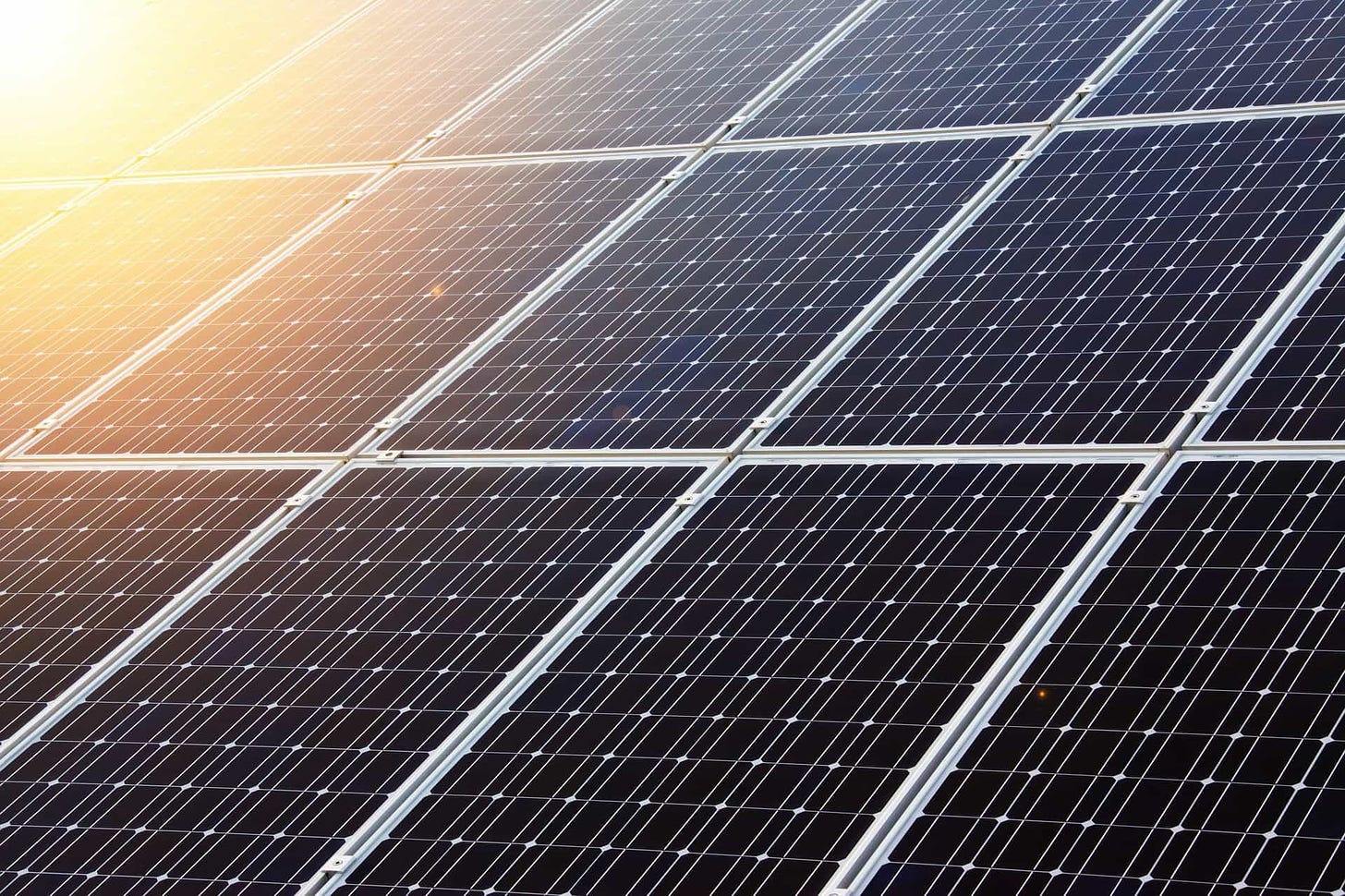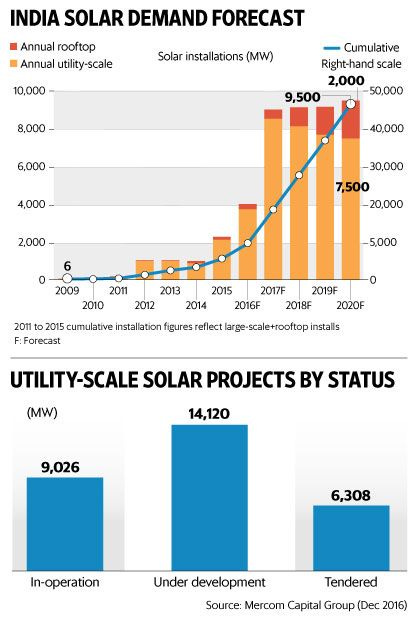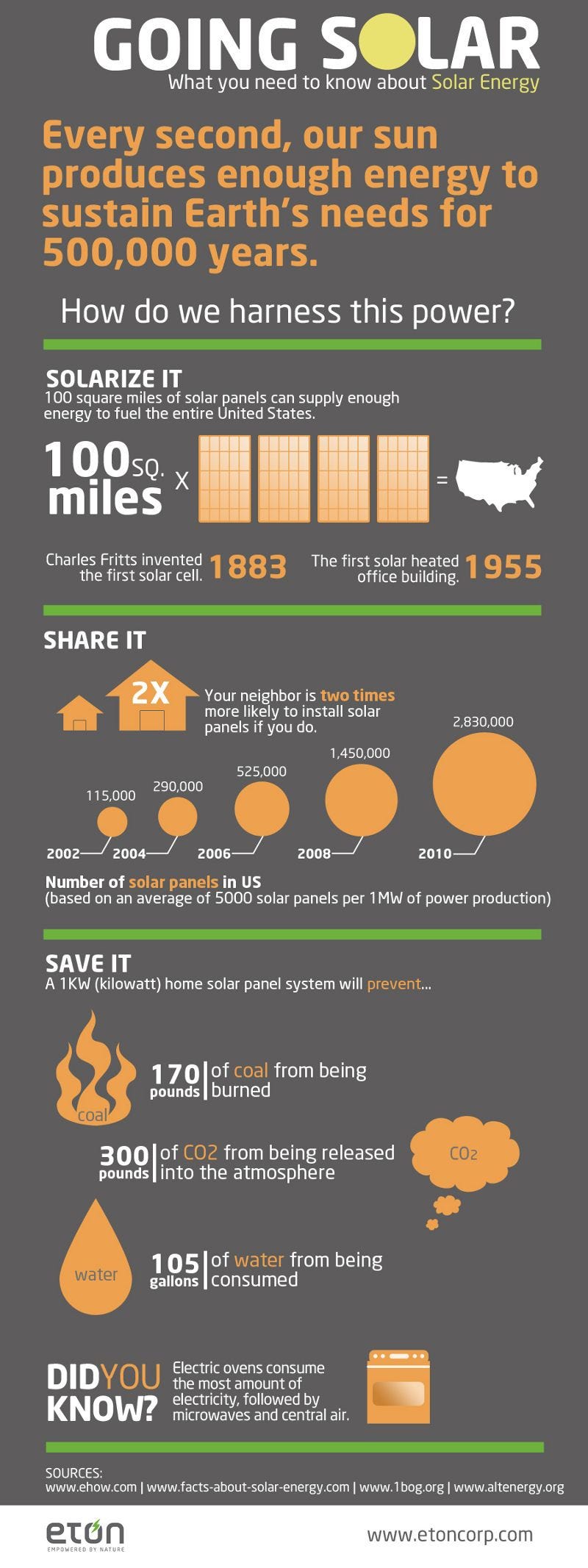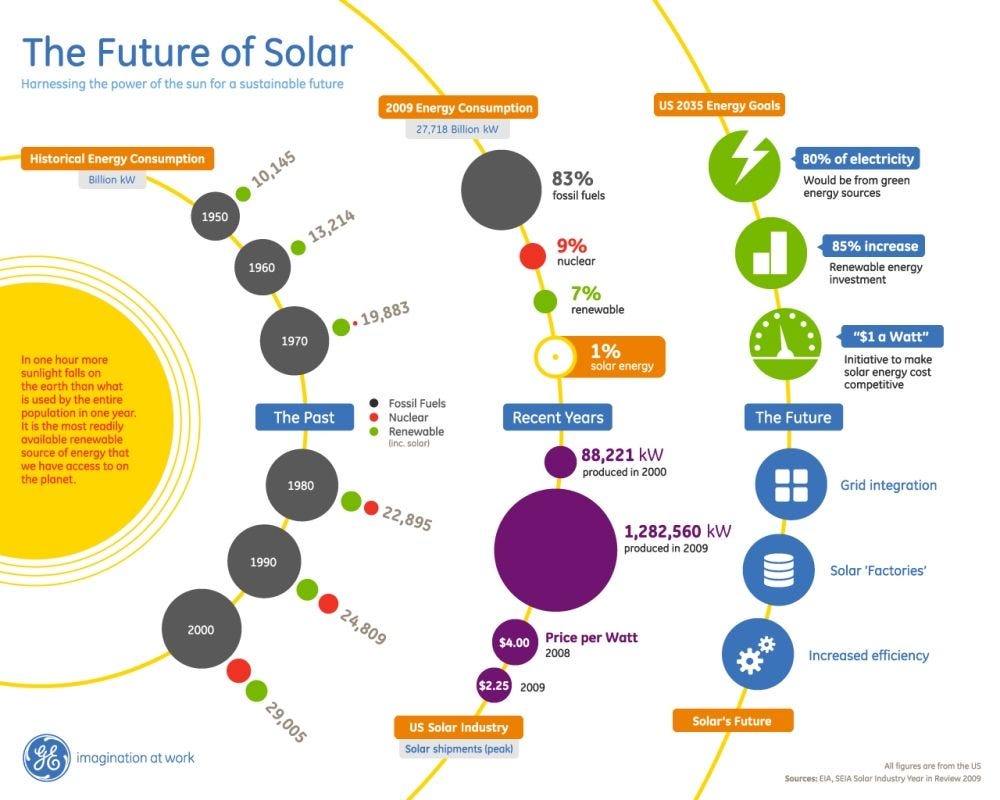Modi Government’s Massive Solar Energy Push in India

Solar power is being pushed strongly in India as an alternative to the fossil fuel options. Mainly because sun is aplenty all year round in most of the country and the use of that energy is free and non-polluting. The main drawback was that such technologies were expensive and the cost for power generated high. But all that has changed. In India, the generation of solar power energy has come down rapidly.
Solar prices are now within 15% of coal, according to KPMG. If current trends hold, the consultancy predicts electricity from solar will actually be 10% cheaper than domestic coal by 2020.
And that could turn out to be a conservative forecast. At a recent government auction, the winning bidder offered to sell electricity generated by a project in sunny Rajasthan for 4.34 rupees (6 cents) per kilowatt hour, roughly the same price as some recent coal projects.
All this has happened thanks to the push for increasing solar capacity in India in the last 3 years. It has been the incorporated into the policy of the Indian government’s main energy vision.
Modi Government's Massive Solar Energy Push in India #environment #SolarPower Click To Tweet
Modi’s push for Solar
Narendra Modi government has been pushing for the Solar energy growth in a big way. What we see today in terms of growth is the result of the initiatives that Modi Government announced in 2014 and pursued since then.
“The Cabinet Committee on Economic Affairs (CCEA), chaired by the Prime Minister Narendra Modi approved the scheme for setting up of 1000 MW of Grid-Connected Solar PV Power Projects with VGF (Viability Gap Fund) support of Rs 1000 crore, by CPSUs under various Central/State Schemes, in three years period from 2015-16 to 2017-18,” a press release said. “The scheme will have a mandatory condition that all PV cells and modules used in solar plants set up under this Scheme, will be made in India,” the release stated.
The Cabinet approved setting up of 25 solar parks of 500 MW capacity each, as also Ultra Mega Solar Power Projects, which will require central government financial support of Rs 4,050 crore.
Prayas – Pradhan Mantri Yojana for Augmenting Solar Manufacturing
PRAYAS is a Rs 21,000 crore ($3.1 bn) package from the Indian Government for India’s solar panel manufacturing industry to boost the production of solar panels and equipment right here in India. Currently, most of this equipment comes from China. The imports are currently at $2 bn a year and if Indian solar power has to grow by 10 GW every year (as the plan is), then we will be reaching imports of $4-5 bn a year!
Very few manufacturers like Vikram Solar and Waaree Solar do have solar panel manufacturing capacity but that is very low at just 500 MW. And, they are just merely assemblers and not real manufacturers of the panels. The solar panel making industry in India is still in its infancy and so is the Indian government’s support policy. PRAYAS is a great attempt, but it is still not going to be enough. Indian government is also pushing to give price advantage to the local manufacturers in the tenders for solar panels.
The government could offer about 9 million rupees a megawatt for manufacturing tenders and 5 million rupees a megawatt for local deployment, according to one of the officials, who said the numbers are subject to change. The plan “might give a price advantage” if the manufacturing-hub logistics are “well planned,” according to Bloomberg New Energy Finance analyst Jenny Chase. Money alone isn’t a sufficient incentive for companies to set up the most high-tech automated factories needed to compete, she said.
Through direct and indirect interventions, the government needs to keep pushing for the growth of the Solar power industry and the use of solar power in India.
Religious Institutions are Joining the Solar Revolution as well
The Modi government has been pushing the use of solar power to everyone – even to religious Ashrams. Even religious institutions. And some – like Art of Living and Radha Soami dera have responded positively.
“Spiritual and interfaith gurus have a large number of domestic and overseas followers who visit their ashrams or meditation centres in big numbers,” Upendra Tripathi, India’s new and renewable energy secretary, told the Times of India newspaper. “So, we feel the gurus are ideally placed to showcase and demonstrate the values and virtues of solar energy to a global audience.”
Presently, an ashram of the Radha Soami Dera sect in Amritsar has one of the world’s largest single rooftop solar power facilities. The system is spread across 80 acres and can generate 19MW of power. The plant was set up in May 2016 by the Hindu religious group.
Other spiritual leaders, including the Bengaluru-based Sri Sri Ravi Shankar, have also been setting up solar power units across villages in the country over the past few years.
And it is not only these religious institutions and Ashrams who have taken up the cause of solar power. There are some small but significant efforts in other places that can have a long term impact in their community. In an female-led mosque (where men and women pray alongside) in Lucknow, solar power has been installed as the way forward!
Set up 20 years ago in a remote corner of Lucknow, Ambar Mosque is known for promoting women’s rights and putting up visitors to a nearby hospital.
Now the female-led faith centre – where women pray alongside men – is installing solar panels to set an example of clean energy in Uttar Pradesh, a state lagging behind its targets.
At 1kW, the system generates a fraction the electricity of the coal plants that dominate India’s power mix. But it is expected to meet three quarters of the mosque’s modest lighting and cooling needs – and its founder hopes to inspire others.
Such progressives in the religious space in India are needed for clean power and long term environmental sustainability to go forward.
Record Growth in Solar Capacity in India
India now has a cumulative capacity of 9012.99 Megawatts. Per the Power and Renewal Energy Minister, the government was now targeting a target that is FIVE times the earlier one now pegged at 100,000 MW for 2022!
“We have reset the targets of renewable energy. The earlier target for solar energy was 20,000 MW till 2022, which we are trying to reset to 100,000 MW,” he said at an event here organised by The Energy and Resources Institute (TERI) University
“On the solar front, we believe there is enormous potential to take it to 100,000 MW in the next 5-7 years,” he added.
Out of all this capacity, the aim is to target a 40GW rooftop solar installation goal by 2022.
A plan for the ‘Grid Connected Rooftop and Small Solar Power Plants Programme’ was outlined in a letter from Ministry of New and Renewable Energy (MNRE) joint secretary Tarun Kapoor to all secretaries of state and group heads of state renewable energy agencies.
States with the highest targets include:
Maharashtra 4,700MW
Uttar Pradesh 4,300MW
Tamil Nadu 3,500MW
Gujarat 3,200MW
Karnataka 2,300MW
Rajasthan 2,300MW
Madhya Pradesh 2,200MW
West Bengal 2,100MW
With such huge targets and strong push by the Modi Government, the capacity this year itself is going to double to 18 GW from the 9 GW. In 2016, there was record growth already of 4 GW of solar capacity. With this kind of growth, India is now at the scale of China, the US and Japan in terms of Solar energy. The projects underway for the coming addition of capacity is 14.2 GW.
A total of about 14.2 GW of solar projects are currently under development and tenders for about 6.3 GW are still to be auctioned, Mercom Capital said in a 4 January report.
The capacity and demand are shown in the graph below.
Just last year, the world’s largest solar plant was opened in Kamuthi, Tamil Nadu, with a capacity of 648 MW over an area of 10 sq km!
Why Solar power?
Solar power is the key for many poor countries where access to electricity is limited. Over 1.5 billion do NOT have access to electricity most of whom are in Sub-Saharan Africa and South Asia. Access to electricity is critical in agricultural productivity, health, education, communications and clean water access. The issues become even more critical in remote rural areas. In such societies using Oil, Gas or Coal is a difficult thing and setting up large hydro power or nuclear projects is well nigh impossible. Of all the green-house gas emissions, 26% are from power generation thereby contributing to the environment.
Let us look at some informative infographics which explain the benefits of Solar power really well.
Here is another one which discusses the use of solar power for different areas and industries.
The future of energy in many societies belongs to to solar. You can find a very useful infographic below on the future possibilities for solar energy.
Featured Image Source: Pixabay







